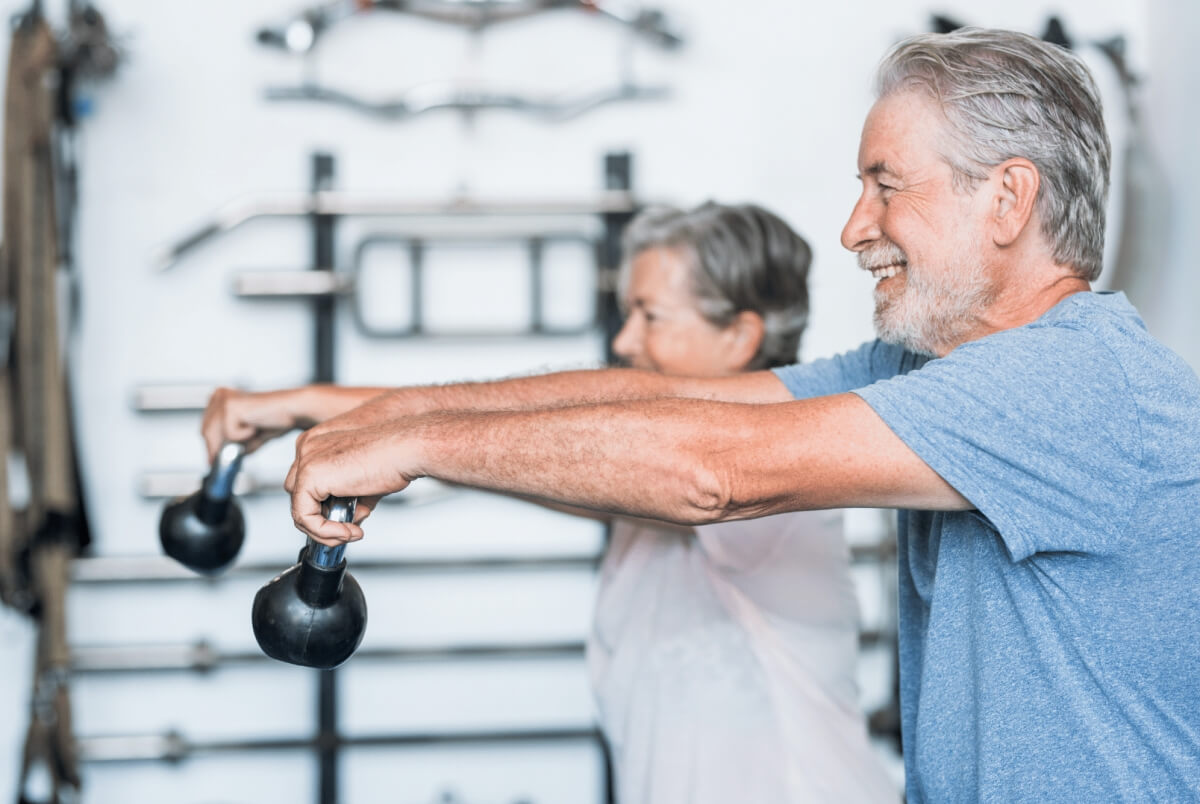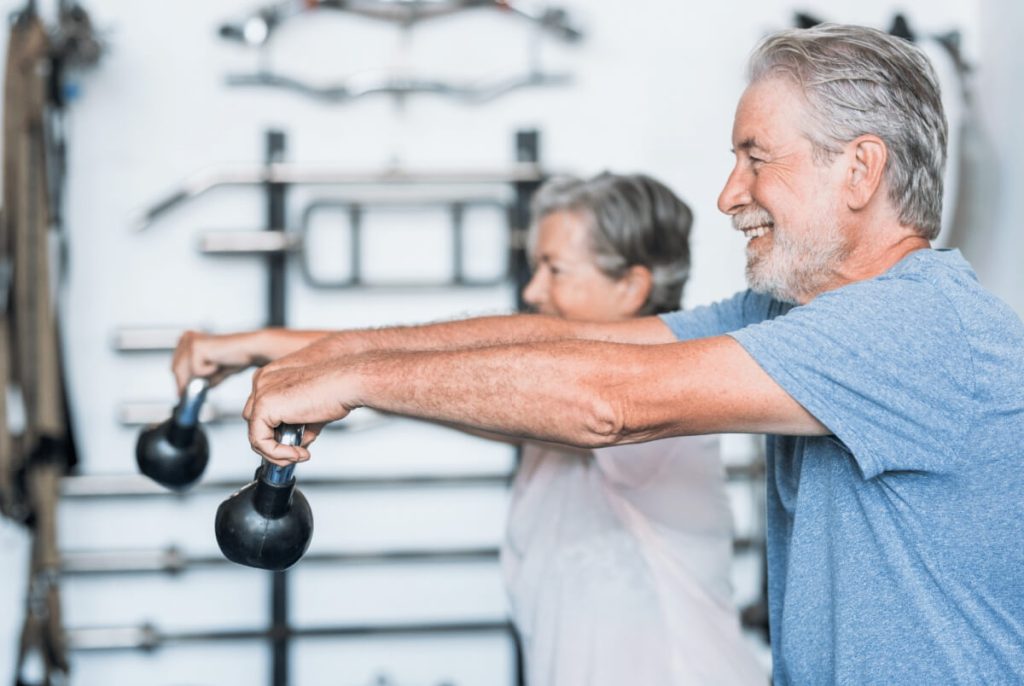
How to Build Muscle Naturally for Women and Men of All Ages


How to Build Muscle Naturally for Women and Men of All Ages
Having adequate muscle mass not only helps you look and feel good, but it’s vital for healthy aging. It extends your lifespan and your healthspan. Your muscle mass helps determine:
- Your risk of falling. Stronger leg muscles can help prevent falls.
- Your ability to carry what you need, like groceries
- How quickly you can move
- How easily you can go up and down the stairs
- Whether you can catch up with your children and grandchildren
These factors help maintain independence and good health into old age. Your musculoskeletal system’s well-being determines your mortality risk, and it really is “survival of the fittest.” Luckily, it’s rarely too late to start building muscle mass. When you combine resistance training and nutrition, you can reap life-improving benefits at any age.
In a recent article, we covered the health benefits of building muscle. In this article, we’ll go in-depth on what you should eat, how to train to build your muscles, and how to maximize your recovery naturally.

Eat a Muscle Gain Diet
There isn’t one particular diet to follow regarding muscle gain. While eating enough calories and protein are the most important factors, there are additional ways to optimize your ability to gain muscle.
Eat Enough Calories
Gaining muscle depends on you consuming enough calories to support muscle growth. If you are running at an energy deficit, it will be difficult for your body to gain muscle. Even a moderate caloric deficit can lead to a loss in muscle production.
In a meta-analysis of studies, researchers explored the relationship between caloric deficit and resistance training on muscle production. Subjects consumed a calorie-restricted diet of about 80% of their estimated energy requirements. While subjects lost an average of around 2.2 lb (1 kg) over ten days, their muscle production decreased by an average of 16%.
The tricky part lies in hitting the “sweet spot” for the right number of calories without increasing your body fat too much. While researchers haven’t figured out an exact formula for the “sweet spot,” they do agree that genetic factors likely play a role.
Most people want to both lean out and look more toned. An easy place to start with this (recomposition) is to start with maintenance calories. Then, if you’re not seeing muscle gain, go up 500 calories and re-measure every 2 weeks.
If you’re fairly lean (under 10% body fat for men and 20% body fat for women) and insulin sensitive, then it may be a good idea to bulk. In this case, considering genetic factors and hormonal responses, we turn to body type as a starting place. Note that this is an imperfect, but helpful way to go about it. There are three major body types:
- Ectomorphs: naturally skinny people
- Mesomorphs: people who gain muscle easily
- Endomorphs: people who gain fat easily
First, identify your body type and use the following recommendations as a guide to determine your calorie intake for muscle gain:
- Ectomorphs: 20 x your body weight (lbs) or 44 x your body weight (kgs)
- Mesomorphs: 18 x your body weight (lbs) or 40 x your body weight (kgs)
- Endomorphs: 16 x your body weight (lbs) or 35 x your body weight (kgs)
Once you start with these guidelines, monitor the scale and your body fat to make necessary adjustments. There are two basic tenets to remember:
- If you’re gaining body fat, you’re eating too many calories.
- If you’re not gaining weight, you’re not eating enough calories.
The best ways to track muscle growth include caliper measurements and DEXA scans.
Mesomorphs and endomorphs need to pay particular attention to eating too many calories and inadvertently gaining too much body fat.
Now that we know roughly how much energy you need (calories) to build muscle, let’s focus on where the energy should come from.
Eat Enough Protein
Just eating enough calories will not give your body what it needs to build muscle. Your skeletal muscles are 20% protein. Therefore, it shouldn’t be a surprise that getting enough protein is critical for building muscles.
How Much Protein Do You Need To Gain Muscles?
How much protein you need depends on your age. The ideal consumption range for most people is 1.6-2.4 g/kg (0.73-1.0 g/lb) of protein per day. More protein than this doesn’t mean better and won’t significantly change your body composition.
While eating caloric surplus, as you should to gain muscle, plan on consuming around 2.4 g/kg (or 1.0 g/lb) of protein daily to minimize fat gain.
Read this blog post for additional specific guidelines for your age and health goals.

Supplements
What about protein supplementation? The bottom line is that protein powder makes reaching your daily protein intake easy and ensures you get a high-quality, complete protein. Whey is considered the best protein for muscle building because it’s quickly-absorbed and high in leucine.
Leucine plays a critical role in muscle growth by signaling the body to begin protein synthesis when essential amino acids and energy from food are available. More on that later.
However, many people react badly to whey. It’s a dairy protein that strongly activates IGF-1, which tends to cause acne in acne-prone people. Whey can sometimes cause gas and upset stomach, which is bad if you’re trying to eat a lot. Lastly, it’s not for those following a plant-based diet.
If you have one of these problems with whey, your next best option is to use a plant-based protein. Pea protein contains around the same percentage of leucine as whey. However, pea protein is not complete protein, and tends to gum up and taste disgusting. This is why we formulated Protein Breakthrough, a delicious plant-based complete protein powder without artificial texturizers.
When To Eat Protein For Muscle Gain
Have you ever heard that a high-protein snack before bed can help you sleep better? There may be a good reason for that, and the time of day you eat protein may also influence your muscle gain.
Most bodybuilders subscribe to eating proteins more often (4 – 8) per day. However, the literature has not consistently shown that it provides better muscle gain results if you’re in a caloric surplus and eating enough protein overall.
A literature review of 21 articles explored the best ways to eat protein to increase muscle mass. They found that people who consumed most of their protein during breakfast and lunch provided more opportunities to get in enough to meet their daily need for muscle gain. Additionally, eating protein before bed can increase muscle protein synthesis overnight.
How frequently throughout the day should you eat? We know that you need amino acids available to activate mTOR (more on that soon) to increase protein synthesis. Research tells us that getting the right amount of calories and nutrients throughout the day is more important than the exact number of meals, but you probably shouldn’t eat fewer than three meals.
In a study of 10 male athletes, researchers wanted to understand the effects of meal frequency on body composition and weight gain. All athletes ate 20 calories/kg body weight in a caloric surplus for eight weeks while on the same training regimen. Half of the participants ate three meals a day, and the others ate six meals a day. Both groups experienced the same amount of muscle and weight gain.
In another study of 16 men and 11 women, subjects consumed a caloric surplus of around 1,200 calories daily in three or six meals while undergoing the same strength training program. While the groups had no difference in fat mass, those who ate three meals a day experienced greater muscle gain.
Optimize For mTOR Activation
We’ve covered that leucine plays a critical role in muscle synthesis, but let’s dig a little more into how. We’ll start with mTOR (mammalian target of rapamycin), a protein that controls cell functions. You need to activate mTOR to trigger muscle protein synthesis. Without muscle synthesis, you can’t grow muscles.
mTOR breaks down into two separate complexes:
- mTORC1 – responsible for cell growth and metabolism
- mTORC2 – responsible for cell division and survival
Targeting mTORC1 is critical for gaining muscle mass.
Without amino acids and insulin, mTORC1 lies dormant. So, how do you activate this nutrient-sensing pathway? The most significant determining factor is ensuring you get enough of the right amino acids in your diet. And the amino acid with more influence on mTORC1 than any other is, you guessed it, leucine.
Consuming enough leucine in your diet prevents the mTORC1 pathway from shutting down, giving your body the green light to keep building muscle.
In a literature review, researchers wanted to explore the role of amino acids in muscle protein synthesis. They found that individuals who consumed essential amino acids enriched with leucine, rapidly and powerfully stimulated protein muscle synthesis.
An effective daily dose of leucine is around 0.12 g kg (0.05 g/lb) of lean body weight. This roughly translates to about 3-7 grams of leucine per meal. Getting it throughout the day stimulates muscle protein synthesis multiple times.

Protein powders are the easiest way to get the necessary leucine. Here is a line-up of some great sources:
- Whey Protein 10 g
- Pea Protein 9 g
- Casein Protein 8 g
- Soy Protein 8 g
- Hemp Protein 6.8 g
- Pumpkin Protein 6.3 g
- Tuna 2.4 g
- Pork Chop 2.2 g
- Chicken Leg 2 g
- Sesame Seeds 1.3 g
- Cottage Cheese 1.27 g
- Canned Navy Beans 0.7 g
- Milk 0.3 g
Optimize Your Fat
Getting enough of the right types of fat is crucial for building muscle. While it doesn’t directly build muscle, fat helps your body maintain healthy hormone levels and proper exercise response to promote muscle growth.
Healthy Testosterone Levels
Testosterone is necessary for building muscle, but it also declines with age. Not consuming enough fat and cholesterol in your diet can result in even lower levels.
A literature review examined the role of nutrition in muscle growth and how it affects hormones. Some of the research highlights include:
- Even moderately reducing total fat consumption – from 40% to 20% – significantly reduces testosterone.
- Low-fat diets may also impair your hormonal response when engaging in resistance training.
- Diets low in saturated fats and high in polyunsaturated and monounsaturated fats may lead to lower testosterone.
Your body needs dietary saturated fat to give it the cholesterol it needs for testosterone production. Animal proteins are an easy source of saturated fat, but coconut oil is an excellent option if you follow a plant-based diet.
Support Inflammation And Exercise Response
When you build muscle, your body creates inflammation and undergoes healing. You need two different types of fat to support this process:
- Long-chain omega-6 fat called arachidonic acid (ARA) supports inflammation.
- Omega-3 fat supports the healing and anti-inflammatory process.
A controlled study of 30 strength-trained males examined the effects of ARA on body composition. Both groups completed eight weeks of strength training three days per week. Only the participants in the ARA group experience an increase in muscle mass and upper body strength.
Ensuring that you consume enough ARA and Omega-3s are necessary for muscle growth. Some great sources of ARA include:
- Sardines
- Salmon
- Eggs
- Beef
- Dairy products
- Seaweed
If you follow a plant-based diet, focus on consuming linoleic acids like nuts and seeds, which can be converted into ARA. If you have weak genetics for converting these fatty acids, ARA supplements are available.
Excellent sources of Omega-3s include:
- Fish and seafood (especially mackerel, salmon, and herring)
- Nuts and seeds (such as flaxseed, chia, and walnuts)
- Plant oils (like flaxseed oil and avocado oil)
Daily Requirement
To optimize your muscle growth, you should start by ensuring you get between 0.5-1.5 g/kg or 0.22-0.68 g/lb of body weight per day of fat. Ultimately, it is up to you to determine the right amount based on what your body tells you.
If you overeat fat, you may find your workouts becoming too difficult or you might begin to gain body fat. If you eat too little fat, you may experience a shift in your mood as your testosterone levels drop, or you may not have enough energy to complete your workouts.
Optimize Digestion
So, we’ve told you that you’re supposed to increase your calories to gain muscle and possibly more fat and protein than you are used to. It can be tough on your digestive system to make such a change. Here are some strategies you can put into place to help ease this transition and maintain the diet you need to build muscle.

Eat Foods That Are Easy On Your Gut
We at BIOptimizers, support Stan Efferding’s Vertical Diet approach by which you choose a few healthy foods you digest easily to help maximize your workouts and support nutrient absorption.
An excellent place to start is by avoiding high-FODMAP (fermentable oligosaccharides, disaccharides, monosaccharides, and polyols) foods. They tend to cause bloating, gas, and discomfort. Some of the major offenders include:
- Wheat
- Garlic
- Onion
- Broccoli
Keeping a food diary is another great way to determine what foods work for you and which ones you should avoid to minimize digestive discomfort.
Take Digestive Enzymes
Increasing your food intake to ensure muscle growth can make digestion a chore. Digestive enzymes to the rescue. They break down your food into smaller pieces making it easier for your gut to absorb those critical nutrients. Digestive enzymes also help even the playing field when it comes to protein powder choice.
In a study of 11 trained males, participants consumed 60 grams of whey protein, pea protein, rice protein, or one of the plant proteins along with digestive enzymes. Researchers took subjects’ blood 30 minutes before and one, two, three, and four hours after consuming the protein powder and digestive enzymes.
When taking digestive enzymes with either rice or pea protein, participants’ amino acid profiles were much more similar to that of whey protein, considered the “gold standard” among protein powders.
BIOptimizers has a great digestive enzyme solution for you: MassZymes. MassZymes helps you absorb essential amino acids while helping to relieve digestive discomfort. It maximizes your protein digestion while also minimizing inflammation caused by food.
Add Probiotics
Probiotics promote healthy digestion and digestive regularity. Adding probiotics to your diet helps optimize your digestion further and maximize your muscle gain.
A meta-analysis of 24 studies explored how probiotics can influence muscle mass gain and strength. Overall, probiotics increase both muscle mass and strength, but it depends on your age. Probiotics:
- Increased muscle mass in individuals under 50, but not over 50
- Increased muscle strength in individuals over 50, but not under 50
- Were most effective in increasing muscle mass and strength when taken for at least 12 weeks
Researchers suggested that increasing protein consumption may overcome the lack of effect of probiotics on muscle growth for individuals over 50.
In particular, Lactobacillus plantarum (L. plantarum) is an effective probiotic for muscle gain. In a study of 54 individuals, those who took L. plantarum experienced increased muscle mass and decreased body fat compared to those who did not.
We’ve got a great source of L. plantarum in Probiotic Breakthrough. Pairing Probiotic Breakthrough along with MassZymes and HCL Breakthrough (for an additional source of digestive enzymes while also restoring healthy stomach acid levels) is just what you need to optimize your digestion.
Now that we’ve covered the nutritional side of muscle gain, let’s move on to the best training strategies.
Train For Muscle Gain

Beyond what you include in your diet, how will you train to gain that muscle? Start by being consistent with your exercise, make a plan, and stick to it. With just this in place, as a beginner, you should experience a lot of muscle gain.
During the first training phase, you’ll want to focus on having correct form and building strength. We recommend working with an experienced coach who can create a well-defined, personalized program, teach, and make corrections as you go.
The number of repetitions and how much weight you lift depends on your training goals:
- For building strength: low repetitions (1-5) with a weight of 80%-100% of the maximum weight you can lift just once (1RM)
- For building muscle: moderate repetitions (8-12) with a weight of 60% – 80% of 1RM. Your last few reps should feel 8 – 9 out of 10 difficult.
- For endurance: high repetitions (15+) with weight below 60% of 1RM
How often do you need to lift weights to build muscle? Studies tell us that what matters is the number of sets you complete in a week rather than how frequently you complete them. The same is true for both trained and untrained individuals.
In a study of 19 trained men and women, subjects completed eight weeks of weight training in two separate groups based on training frequency:
- High frequency: completed three sets of eight to 12 reps three days per week
- Low frequency: completed nine sets of eight to 12 reps one day per week
Both groups experienced an increase of about 1 kg (2.2 lbs) in muscle mass.
Once you start a program, stick to it for a few months. Give your body a chance to respond, and don’t jump between programs.
Maximize Recovery
Your journey to building muscle doesn’t end as soon as you walk out of a training session. Beyond nutrition, you also need to make sure to maximize your recovery. You can only get as much muscle gain as you can recover.
Optimize Your Sleep
Sleep is the #1 most important factor to ensure proper muscle recovery and muscle protein synthesis. Not getting enough sleep can lead to muscle loss and even fat gain.
While you sleep, your muscles get an extra boost of blood supply, nutrients, and oxygen. Deep sleep (non-REM), in particular, is part of recovery by releasing human growth hormone (HGH) and increasing protein synthesis to build and repair your muscles.
When you don’t get enough sleep, you spend less time in deep sleep resulting in a decrease in HGH and less time for protein synthesis.
A study of 13 males and females examined the effects of sleep deprivation on muscle protein synthesis. Each participant went through one night of sleep deprivation and one night of normal sleep. After just one night of sleep deprivation, subjects experienced an average of 18% reduced muscle synthesis compared to the night of normal sleep.
Researchers also found that after one night of sleep deprivation, subjects had:
- Lower levels of testosterone and insulin growth factor-1, which build your muscles
- Higher levels of cortisol which can destroy your muscles
Set yourself up for success by getting seven to nine hours of sleep per night.
Beyond the amount of sleep you get, quality matters too. Quality sleep means you get adequate deep and REM sleep with minimal disruptions. This article can teach you all about sleep quality with some tips for success.
Avoid The Wrong Pain Management That Inhibits Muscle Growth
We all know that soreness and discomfort can come with weight training and starting a new routine. How you manage your pain could make or break your muscle gain.
Bottom line – minimize your use of anti-inflammatories like NSAIDs. Taken at a high dosage, they inhibit muscle protein synthesis after exercise, undermining your hard work.
In a study of 31 men and women, subjects took either 1200 mg of ibuprofen or 75 mg of aspirin daily for eight weeks while completing supervised resistance training. Overall, participants who took aspirin experienced more muscle growth and strength than those who took ibuprofen.
When it comes to ice baths or cold therapy, wait at least 4 hours after training to support muscle growth.
A controlled study of 30 active men compared the effects of cold water and active recovery on muscle mass and strength after strength training. For 12 weeks, participants who underwent cold water immersion therapy after training experienced reduced long-term muscle gain and strength.
So, if both NSAIDs and cold therapy aren’t the best way, what is safe to use after training to support muscle growth and help with soreness? Systemic enzymes. They work throughout your body in every system and organ.
In a controlled clinical trial, 73 participants completed slow, repetitive exercise until exhausted while taking either systemic enzymes or a placebo 72 hours before and after the training day. Those who took the systemic enzymes experienced less muscle fatigue and pain than the placebo group.
Use Post-Workout Nutrition Wisely And Eat Your Carbs
We’ve talked about what you need to include in your diet to ensure muscle growth, but some consider what you eat post-workout to be more important than what you eat throughout the day.
A meta-analysis explored the effects of post-workout nutrition. Overall, the researchers found mixed results but concluded the following:
- Immediately eating post-workout is critical when you take up resistance training after an overnight fast.
- Suppose you consume essential amino acids or high-quality protein before exercise. In that case, it lasts into the post-workout period leaving you 1-2 hours before a protein-rich meal is necessary.
- If you begin training 3-4 hours after your most recent meal, it’s best to consume a protein-rich meal (around 25g) as soon as possible post-workout.
- The older you are, the more protein you should consume post-workout to increase muscle protein synthesis – around 20g of protein for younger individuals and around 40g for older individuals.
When you train, your body takes carbohydrates from your bloodstream, liver, or muscle glycogen, and you must replenish them post-workout. Just running out of glycogen stores can cause your body to break down muscle.
While it’s possible to train on a low-carb diet, it’s only because your body has figured out how to produce glucose from fats, ketones, or amino acids. Carbs are necessary to increase insulin to kick muscle protein synthesis into gear. When combined with protein 2:1, carbs can trigger the greatest insulin release and help bring glucose and amino acids into your muscles.
White rice is a great option if you struggle to reach your calorie needs, and it’s easy to digest. If you only want to increase your calories moderately, go for some complex carbs like:
- Sweet potatoes
- Yams
- Oats
- Quinoa
- Potatoes
Starches or glucose are generally better for muscle building than sugars like fructose or glucose.
The Takeaway
No matter your age, it’s never too late to increase your muscle mass, and it will boost your lifespan and healthspan. The proper nutrition, training, and recovery will have you well on your way to muscle gain. Get started by:
- Eating the right amount of extra calories and protein throughout the day based on your body type
- Getting enough of the right amounts of fat like arachidonic acid and omega-3s to support inflammation and recovery response
- Choosing foods that are easy to digest and supporting your digestion with supplements like Probiotic Breakthrough, MassZymes, and HCL Breakthrough
- Working with a personal trainer to develop the right training plan for you and sticking to it
- Getting enough high-quality sleep
- Avoiding NSAIDs for pain relief and instead try systemic enzymes
Ensuring you get enough protein before or after training and keeping your body supplied with carbs to support protein muscle synthesis
References
- McLeod M, Breen L, Hamilton DL, Philp A. Live strong and prosper: the importance of skeletal muscle strength for healthy ageing. Biogerontology. 2016;17(3):497-510. doi:10.1007/s10522-015-9631-7
- Slater GJ, Dieter BP, Marsh DJ, Helms ER, Shaw G, Iraki J. Is an energy surplus required to maximize skeletal muscle hypertrophy associated with resistance training. Front Nutr. 2019;6:131. doi:10.3389/fnut.2019.00131
- Antonio J, Ellerbroek A, Silver T, Vargas L, Peacock C. The effects of a high protein diet on indices of health and body composition–a crossover trial in resistance-trained men. J Int Soc Sports Nutr. 2016;13(1):3. doi:10.1186/s12970-016-0114-2
- Antonio J, Peacock CA, Ellerbroek A, Fromhoff B, Silver T. The effects of consuming a high protein diet (4.4 g/kg/d) on body composition in resistance-trained individuals. J Int Soc Sports Nutr. 2014;11(1):19. doi:10.1186/1550-2783-11-19
- Antonio J, Ellerbroek A, Silver T, et al. A high protein diet (3.4 g/kg/d) combined with a heavy resistance training program improves body composition in healthy trained men and women–a follow-up investigation. J Int Soc Sports Nutr. 2015;12(1):39. doi:10.1186/s12970-015-0100-0
- Jäger R, Kerksick CM, Campbell BI, et al. International Society of Sports Nutrition Position Stand: protein and exercise. J Int Soc Sports Nutr. 2017;14(1). doi:10.1186/s12970-017-0177-8
- Garlick PJ. The role of leucine in the regulation of protein metabolism. J Nutr. 2005;135(6 Suppl):1553S-6S. doi:10.1093/jn/135.6.1553S
- Moore DR, Philp A. Editorial: Nutritional strategies to promote muscle mass and function across the health span. Front Nutr. 2020;7:569270. doi:10.3389/fnut.2020.569270
- Hansen Ø, Therese FM, RaastadTruls. The Meal Frequency Project : The effect of meal frequency on body composition during 12-weeks of strength training. In: 12th Annual Congress of the ECSS. ; 2007. Accessed February 23, 2023. https://www.duo.uio.no/handle/10852/28684
- Taguchi M, Hara A, Murata H, Torii S, Sako T. Increasing meal frequency in isoenergetic conditions does not affect body composition change and appetite during weight gain in Japanese athletesIncreasing meal frequency in isoenergetic conditions does not affect body composition change and appetite during weight gain in Japanese athletes. Int J Sport Nutr Exerc Metab. 2021;31(2):109-114. doi:10.1123/ijsnem.2020-0139
- Dibble CC, Manning BD. Signal integration by mTORC1 coordinates nutrient input with biosynthetic output. Nat Cell Biol. 2013;15(6):555-564. doi:10.1038/ncb2763
- Zou Z, Tao T, Li H, Zhu X. mTOR signaling pathway and mTOR inhibitors in cancer: progress and challenges. Cell Biosci. 2020;10(1):31. doi:10.1186/s13578-020-00396-1
- Yoon MS. MTOR as a key regulator in maintaining skeletal muscle mass. Front Physiol. 2017;8:788. doi:10.3389/fphys.2017.00788
- Liu GY, Sabatini DM. mTOR at the nexus of nutrition, growth, ageing and disease. Nat Rev Mol Cell Biol. 2020;21(4):183-203. doi:10.1038/s41580-019-0199-y
- Drummond MJ, Rasmussen BB. Leucine-enriched nutrients and the regulation of mammalian target of rapamycin signalling and human skeletal muscle protein synthesis. Curr Opin Clin Nutr Metab Care. 2008;11(3):222-226. doi:10.1097/MCO.0b013e3282fa17fb
- Stanworth RD, Jones TH. Testosterone for the aging male; current evidence and recommended practice. Clin Interv Aging. 2008;3(1):25-44. doi:10.2147/cia.s190
- Helms ER, Aragon AA, Fitschen PJ. Evidence-based recommendations for natural bodybuilding contest preparation: nutrition and supplementation. J Int Soc Sports Nutr. 2014;11(1):20. doi:10.1186/1550-2783-11-20
- De Souza EO, Lowery RP, Wilson JM, et al. Effects of arachidonic acid supplementation on acute anabolic signaling and chronic functional performance and body composition adaptations. PLoS One. 2016;11(5):e0155153. doi:10.1371/journal.pone.0155153
- Tachtsis B, Camera D, Lacham-Kaplan O. Potential roles of n-3 PUFAs during skeletal muscle growth and regeneration. Nutrients. 2018;10(3). doi:10.3390/nu10030309
- Salem N Jr, Pawlosky R, Wegher B, Hibbeln J. In vivo conversion of linoleic acid to arachidonic acid in human adults. Prostaglandins Leukot Essent Fatty Acids. 1999;60(5-6):407-410. doi:10.1016/s0952-3278(99)80021-0
- Omega-3 fatty acids. Nih.gov. Accessed February 23, 2023. https://ods.od.nih.gov/factsheets/Omega3FattyAcids-Consumer/
- Iraki J, Fitschen P, Espinar S, Helms E. Nutrition recommendations for bodybuilders in the off-season: A narrative review. Sports. 2019;7(7):154. doi:10.3390/sports7070154
- Killian LA, Muir JG, Barrett JS, Burd NA, Lee SY. High fermentable oligosaccharides, disaccharides, monosaccharides, and polyols (FODMAP) consumption among endurance athletes and relationship to gastrointestinal symptoms. Front Nutr. 2021;8:637160. doi:10.3389/fnut.2021.637160
- Minevich J, Olson MA, Mannion JP, et al. Digestive enzymes reduce quality differences between plant and animal proteins: a double-blind crossover study. J Int Soc Sports Nutr. 2015;12(1):26. doi:10.1186/1550-2783-12-S1-P26
- Huang WC, Lee MC, Lee CC, et al. Effect of Lactobacillus plantarum TWK10 on exercise physiological adaptation, performance, and body composition in healthy humans. Nutrients. 2019;11(11):2836. doi:10.3390/nu11112836
- Schoenfeld BJ, Grgic J, Van Every DW, Plotkin DL. Loading recommendations for muscle strength, hypertrophy, and local endurance: A re-examination of the repetition continuum. Sports. 2021;9(2):32. doi:10.3390/sports9020032
- Thomas MH, Burns SP. Increasing Lean Mass and Strength: A Comparison of High Frequency Strength Training to Lower Frequency Strength Training. Int J Exerc Sci. 2016;9(2):159-167.
- Ralston GW, Kilgore L, Wyatt FB, Buchan D, Baker JS. Weekly training frequency effects on strength gain: A meta-analysis. Sports Med Open. 2018;4(1). doi:10.1186/s40798-018-0149-9
- Thomas MH, Burns SP. Increasing lean mass and strength: A comparison of high frequency strength training to lower frequency strength training. Int J Exerc Sci. 2016;9(2):159-167.
- Cedernaes J, Schönke M, Westholm JO, et al. Acute sleep loss results in tissue-specific alterations in genome-wide DNA methylation state and metabolic fuel utilization in humans. Sci Adv. 2018;4(8):eaar8590. doi:10.1126/sciadv.aar8590
- Van Cauter E, Plat L. Physiology of growth hormone secretion during sleep. J Pediatr. 1996;128(5 Pt 2):S32-7. doi:10.1016/s0022-3476(96)70008-2
- Jarmasz JS, Jin Y, Vakili H, Cattini PA. Sleep deprivation and diet affect human GH gene expression in transgenic mice in vivo. Endocr Connect. 2020;9(12):1135-1147. doi:10.1530/EC-20-0354
- Lamon S, Morabito A, Arentson-Lantz E, et al. The effect of acute sleep deprivation on skeletal muscle protein synthesis and the hormonal environment. Physiol Rep. 2021;9(1):e14660. doi:10.14814/phy2.14660
- Krentz JR, Quest B, Farthing JP, Quest DW, Chilibeck PD. The effects of ibuprofen on muscle hypertrophy, strength, and soreness during resistance training. Appl Physiol Nutr Metab. 2008;33(3):470-475. doi:10.1139/H08-019
- Lilja M, Mandić M, Apró W, et al. High doses of anti-inflammatory drugs compromise muscle strength and hypertrophic adaptations to resistance training in young adults. Acta Physiol (Oxf). 2018;222(2):e12948. doi:10.1111/apha.12948
- Roberts LA, Raastad T, Markworth JF, et al. Post-exercise cold water immersion attenuates acute anabolic signalling and long-term adaptations in muscle to strength training: Cold water immersion and adaptation to strength training. J Physiol. 2015;593(18):4285-4301. doi:10.1113/JP270570
- Marzin T, Lorkowski G, Reule C, et al. Effects of a systemic enzyme therapy in healthy active adults after exhaustive eccentric exercise: a randomised, two-stage, double-blinded, placebo-controlled trial. BMJ Open Sport Exerc Med. 2016;2(1):e000191. doi:10.1136/bmjsem-2016-000191
- Aragon AA, Schoenfeld BJ. Nutrient timing revisited: is there a post-exercise anabolic window? J Int Soc Sports Nutr. 2013;10(1):5. doi:10.1186/1550-2783-10-5
- Kerksick CM, Arent S, Schoenfeld BJ, et al. International society of sports nutrition position stand: nutrient timing. J Int Soc Sports Nutr. 2017;14(1). doi:10.1186/s12970-017-0189-4
- Fujita S, Rasmussen BB, Cadenas JG, Grady JJ, Volpi E. Effect of insulin on human skeletal muscle protein synthesis is modulated by insulin-induced changes in muscle blood flow and amino acid availability. Am J Physiol Endocrinol Metab. 2006;291(4):E745-54. doi:10.1152/ajpendo.00271.2005
- van Loon LJC, Kruijshoop M, Verhagen H, Saris WHM, Wagenmakers AJM. Ingestion of protein hydrolysate and amino acid–carbohydrate mixtures increases postexercise plasma insulin responses in men. J Nutr. 2000;130(10):2508-2513. doi:10.1093/jn/130.10.2508
